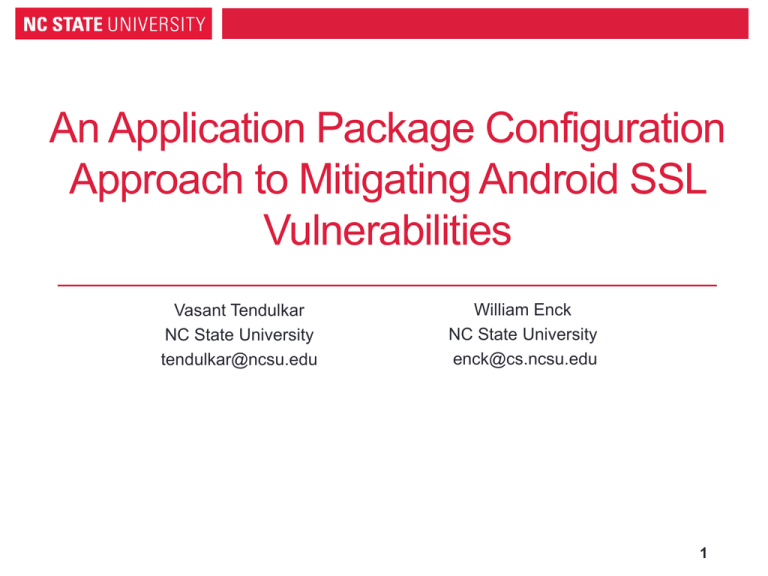An-Application-Package-Configuration-Approach-to
advertisement

An Application Package Configuration
Approach to Mitigating Android SSL
Vulnerabilities
Vasant Tendulkar
NC State University
tendulkar@ncsu.edu
William Enck
NC State University
enck@cs.ncsu.edu
1
Introduction
• Smartphones are integral to our daily lives
• Applications deal with a variety of sensitive user data
• Sensitive personal data needs to be protected from eavesdropping
• SSL = de facto standard for securing communication over the internet
2
Recent research on SSL in non-browser
software
• Georgiev et al., The most dangerous code in the world: validating ssl
certicates in non-browser software. CCS '12
• Fahl et al., Rethinking SSL development in an appified world. CCS’13
• Their findings:
• SSL certificate validation is completely broken in many critical applications
and libraries
• Android applications are vulnerable to Man in the Middle attack
3
SSL in Non-browser software
• Traditionally, SSL was mostly used in browsers and email clients
• Handful of applications were thoroughly verified
• Now, SSL verification logic has moved to smartphone applications
• Any application can change the verification logic
Then
Now
4
Recent research on SSL in non-browser
software
• Suggested Solutions:
• Modify existing classes in Android to force SSL verification
• Enforce SSL verification within an application
• Implement SSL pinning in Android
5
Using SSL in Android
1.
Create a connection using default Android APIs
I.
UrlConnection
II. HttpsUrlConnection
III.WebView.loadUrl
= new
URL("https://www.google.com");
URLURL
u = unew
URL("https://www.google.com");
WebView
wv = (WebView)findViewById(R.id.webview);
URLConnection
uch =
u.openConnection();u.openConnection();
HttpsURLConnection
=(HttpsURLConnection)
wv.loadUrl("https://www.google.com");
6
Our Hypotheses
H1: Developers use self-signed certificates during either debugging
or at deployment and add custom SSL verification code to
accommodate these certificates
H2: Developers use SSL Pinning to make the application more
secure and customize SSL verification to only trust the pinned
certificate
7
Proposed Solution
• Push the customization of SSL verification logic to the application package
manifest
• Makes it declarative and easy to modify
• It is easy to remove if the customization is temporary
• Solution approaches:
1. Linking application debugging with SSL verification
2. Allowing SSL Pinning as an Application manifest policy
8
Linking application debugging with SSL
verification
• Android uses a debug flag in the manifest to denote that the
application is in debug phase
• android:debuggable=“true”
9
Allowing SSL Pinning as an Application
manifest policy
<!-- SSL Pinning Configuration-->
<uses-SSLPinning
useDefaultTrustStore=true >
<!-- Self-Signed Server Certificate Fingerprint-->>
<SSCert name="mycert" algo="SHA-1” val="B8:01:86:D1.."/>
<!-- Issuer Certificate Authority Fingerprint-->>
<SSCert name="cacert" algo="SHA-1" val="93:E6:AB:22.."/>
</uses-SSLPinning>
10
Hypotheses…revisited
H1: Developers use self-signed certificates during either debugging
or at deployment and add custom SSL verification code to
accommodate these certificates
H2: Developers use SSL Pinning to make the application more
secure and customize SSL verification to trust only the pinned
certificate(s)
11
Experiment Methodology
• We focus on vulnerabilities introduced due to custom verification code
added by the developer
• We do not include SSL code introduced by advertisement or analytics
libraries
12
Why developers customize SSL
• Most common reasons:
• Developer is using a self-signed certificate
• Developer is using a certificate signed by a CA not yet trusted by Android
• Developer does not know how to use SSL
• Developer wants to use the same certificate on multiple servers
13
Code Patterns for Insecure SSL verification
• The Trust-All or Any Certificate pattern
TrustManager TA = new X509TrustManager(){
public void checkServerTrusted(X509Certificate[] c, String at)
throws CertificateException
{
// <- Empty Code Block = No certificate verification
}
};
14
Why developers customize SSL
• Most common reasons:
• Developer is using a self-signed certificate
• Developer is using a certificate signed by a CA not yet trusted by Android
• Developer does not know how to use SSL
• Developer wants to use the same certificate on multiple servers
15
Experiment I – Analysis of Open-Source Apps
• Obtain source code for 240 open-source applications from F-Droid
• Analyzed the certificate verification logic in the applications
• Analyzed the SSL certificates used by the application
• Verified against root CA store of Android ver. 2.3.3, 4.0, 4.1, 4.2
• Results:
1.
26 out of 240 applications use SSL
2.
10 out of the 26 applications use insecure certificate verification logic
3.
-
6 applications do not verify any certificate
-
3 applications do not verify server hostname
-
1 application does neither
Only 2 applications use self-signed certificates
16
Experiment II - Analysis of Play Store applications
• Obtained 13,000 applications from Google Play Store in January 2013
• Identified 4,985 applications that use SSL
• Categorized apps based on where SSL was used
• src_only
• src_and_ads
• ads_only
• Verify SSL certificate used by the application
• Verified against root CA store of Android ver. 2.3.3, 4.0, 4.1, 4.2
• Randomly selected 200 applications for manual analysis
17
Manual analysis of Play Store applications
• Decompiled applications to Java source using Dare and Soot
• 137 out of 200 applications use SSL in non-advertisement code
• 84 applications use insecure SSL verification code
• Only 5 applications use self-signed certificates, rest 79 applications use
genuine, valid SSL certificates
18
Analysis of Google Play Store applications
• 3,165 applications out of remaining 4,785 used SSL in non-advertisement code
• Used Androguard to obtain source-code of classes using SSL in these applications
• Pruned known implementations of insecure SSL verification and analyzed the
remaining code for each application
• Results:
• 1,805 applications out of 3,165 applications bypass SSL verification within the
application
• Only 124 applications out of these 1,805 applications use alternative certificates
• Rest 1,681 applications use genuine, valid SSL certificates
19
Results
• 3,302 applications using SSL in nonadvertisement code
• 57.2% applications using insecure
SSL certificate verification logic
•
•
•
1,319 applications trusting all
certificates
47 applications trusting all hostnames
523 applications trusting both
20
Results
21
Conclusion
• Investigated Man-In-The-Middle SSL vulnerabilities in Android
applications
• Identified insufficient API support for commonly used features as the
driving reason for developers writing custom SSL verification code
• Proposed two application package configuration based solutions to
prevent MitM vulnerabilities
• Demonstrated that more than 50% of applications using SSL in non-
advertisement code would benefit from our solutions
22
Thank you
Vasant Tendulkar
Department of Computer Science
North Carolina State University
Email : tendulkar AT ncsu.edu
Questions?
23





